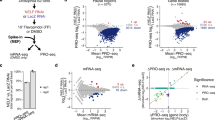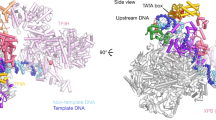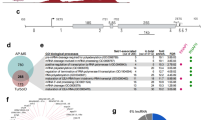Abstract
The RNA polymerase II elongation complex contains several factors that facilitate transcription elongation and catalyse the processing of precursor messenger RNAs (pre-mRNAs)1,2,3. The conserved elongation factor Spt6 is recruited rapidly and robustly to sites of active transcription4,5. Here we show that Drosophila Spt6 (dSpt6) co-purifies with the exosome, a complex of 3′ to 5′ exoribonucleases that is implicated in the processing of structural RNA and in the degradation of improperly processed pre-mRNA6,7,8,9,10. Immunoprecipitation assays of Drosophila nuclear extracts show that the exosome also associates with the elongation factor dSpt5 and RNA polymerase II. In vivo, exosome subunits colocalize with dSpt6 at transcriptionally active loci on polytene chromosomes during normal development and are strongly recruited to heat-shock loci on gene induction. At higher resolution, chromatin immunoprecipitation analysis shows that the exosome is recruited to transcriptionally active units of heat-shock genes. These data provide a physical basis for the hypothesis that exosome-mediated pre-mRNA surveillance accompanies transcription elongation.
This is a preview of subscription content, access via your institution
Access options
Subscribe to this journal
Receive 51 print issues and online access
$199.00 per year
only $3.90 per issue
Buy this article
- Purchase on Springer Link
- Instant access to full article PDF
Prices may be subject to local taxes which are calculated during checkout



Similar content being viewed by others
References
Hirose, Y. & Manley, J. L. RNA polymerase II and the integration of nuclear events. Genes Dev. 14, 1415–1429 (2000)
Bentley, D. Coupling RNA polymerase II transcription with pre-mRNA processing. Curr. Opin. Cell Biol. 11, 347–351 (1999)
Proudfoot, N. J., Furger, A. & Dye, M. J. Integrating mRNA processing with transcription. Cell 108, 501–512 (2002)
Kaplan, C. D., Morris, J. R., Wu, C. & Winston, F. Spt5 and spt6 are associated with active transcription and have characteristics of general elongation factors in D. melanogaster. Genes Dev. 14, 2623–2634 (2000)
Andrulis, E. D., Guzman, E., Doring, P., Werner, J. & Lis, J. T. High-resolution localization of Drosophila Spt5 and Spt6 at heat shock genes in vivo: roles in promoter proximal pausing and transcription elongation. Genes Dev. 14, 2635–2649 (2000)
Hilleren, P., McCarthy, T., Rosbash, M., Parker, R. & Jensen, T. H. Quality control of mRNA 3′-end processing is linked to the nuclear exosome. Nature 413, 538–542 (2001)
Butler, J. S. The yin and yang of the exosome. Trends Cell Biol. 12, 90–96 (2002)
Bousquet-Antonelli, C., Presutti, C. & Tollervey, D. Identification of a regulated pathway for nuclear pre-mRNA turnover. Cell 102, 765–775 (2000)
van Hoof, A., Frischmeyer, P. A., Dietz, H. C. & Parker, R. Exosome-mediated recognition and degradation of mRNAs lacking a termination codon. Science 295, 2262–2264 (2002)
Torchet, C. et al. Processing of 3′-extended read-through transcripts by the exosome can generate functional mRNAs. Mol. Cell 9, 1285–1296 (2002)
Hartzog, G. A., Wada, T., Handa, H. & Winston, F. Evidence that Spt4, Spt5, and Spt6 control transcription elongation by RNA polymerase II in Saccharomyces cerevisiae. Genes Dev. 12, 357–369 (1998)
Bortvin, A. & Winston, F. Evidence that Spt6p controls chromatin structure by a direct interaction with histones. Science 272, 1473–1476 (1996)
Gavin, A. C. et al. Functional organization of the yeast proteome by systematic analysis of protein complexes. Nature 415, 141–147 (2002)
Allmang, C. et al. The yeast exosome and human PM-Scl are related complexes of 3′ → 5′ exonucleases. Genes Dev. 13, 2148–2158 (1999)
Mitchell, P., Petfalski, E., Shevchenko, A., Mann, M. & Tollervey, D. The exosome: a conserved eukaryotic RNA processing complex containing multiple 3′ → 5′ exoribonucleases. Cell 91, 457–466 (1997)
Mitchell, P. & Tollervey, D. Musing on the structural organization of the exosome complex. Nature Struct. Biol. 7, 843–846 (2000)
Lis, J. T., Mason, P., Peng, J. & Price, D. H. P-TFFb kinase recruitment and function at heat shock loci. Genes Dev. 14, 792–803 (2000)
Erdjument-Bromage, H. et al. Examination of micro-tip reversed-phase liquid chromatographic extraction of peptide pools for mass spectrometric analysis. J. Chromatogr. A 826, 167–181 (1998)
Geromanos, S., Freckleton, G. & Tempst, P. Tuning of an electrospray ionization source for maximum peptide-ion transmission into a mass spectrometer. Anal. Chem. 72, 777–790 (2000)
Mann, M., Hojrup, P. & Roepstorff, P. Use of mass spectrometric molecular weight information to identify proteins in sequence databases. Biol. Mass. Spectrom. 22, 338–345 (1993)
Fenyo, D., Qin, J. & Chait, B. T. Protein identification using mass spectrometric information. Electrophoresis 19, 998–1005 (1998)
Park, J. M., Werner, J., Kim, J. M., Lis, J. T. & Kim, Y. J. Mediator, not holoenzyme, is directly recruited to the heat shock promoter by HSF upon heat shock. Mol. Cell 8, 9–19 (2001)
Shopland, L. S. & Lis, J. T. HSF recruitment and loss at most Drosophila heat shock loci is coordinated and depends on proximal promoter sequences. Chromosoma 105, 158–171 (1996)
Acknowledgements
We thank members of the Lis laboratory for comments on the manuscript. This work was supported by an NIH grant to J.T.L., a National Research Service Award to E.D.A., and a National Cancer Institute (NCI) Cancer Center Support Grant to P.T.
Author information
Authors and Affiliations
Corresponding authors
Ethics declarations
Competing interests
The authors declare that they have no competing financial interests.
Rights and permissions
About this article
Cite this article
Andrulis, E., Werner, J., Nazarian, A. et al. The RNA processing exosome is linked to elongating RNA polymerase II in Drosophila. Nature 420, 837–841 (2002). https://doi.org/10.1038/nature01181
Received:
Accepted:
Issue Date:
DOI: https://doi.org/10.1038/nature01181
This article is cited by
-
Differential expression of RNA exosome subunits in the amphibian Lithobates catesbeianus during reproductive and non-reproductive periods
BMC Research Notes (2019)
-
Noncoding RNA transcription targets AID to divergently transcribed loci in B cells
Nature (2014)
-
The RNA exosome promotes transcription termination of backtracked RNA polymerase II
Nature Structural & Molecular Biology (2014)
-
Transcriptome and proteome quantification of a tumor model provides novel insights into post‐transcriptional gene regulation
Genome Biology (2013)
-
The human cap-binding complex is functionally connected to the nuclear RNA exosome
Nature Structural & Molecular Biology (2013)
Comments
By submitting a comment you agree to abide by our Terms and Community Guidelines. If you find something abusive or that does not comply with our terms or guidelines please flag it as inappropriate.



